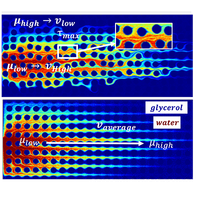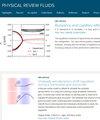From mixing to displacement of miscible phases in porous media: The role of heterogeneity and inlet pressures
IF 2.5
3区 物理与天体物理
Q2 PHYSICS, FLUIDS & PLASMAS
引用次数: 0
Abstract
Miscible multiphase flow in porous media is a key phenomenon in various industrial and natural processes, such as hydrogen storage and geological carbon sequestration. However, the parameters controlling the patterns of displacement and mixing in these flows are not completely resolved. This study delves into the effects of heterogeneity and inlet pressure on mixing and displacement patterns of low-viscosity miscible phase invasion into a high-viscosity resident phase, that is saturating a porous medium. The findings highlight the substantial influence of inlet pressures and heterogeneity levels in transitioning from uniform to fingering patterns at the pore scale. These phenomena are detectable at the Darcy scale, and their transition from a uniform front to finger formation is effectively marked through a modified Sherwood number. This modified Sherwood number links microscale patterns to physical properties such as velocity distribution, diffusion, and viscosity contrasts. Additionally, the study employs breakthrough curve (BTC) analysis to illustrate the role of higher heterogeneity and inlet pressure in broadening the fluid velocity distribution, leading to the fingering pattern. These research insights provide a nondimensional approach that scales the BTCs, and can serve future models of miscible phase flow in porous media, linking pore-scale dynamics with macroscale Darcy-scale observations.

从混合到多孔介质中混相的置换:异质性和入口压力的作用
多孔介质中的混溶多相流是各种工业和自然过程(如氢储存和地质碳封存)中的一个关键现象。然而,控制这些流动中置换和混合模式的参数尚未完全解决。本研究深入探讨了异质性和入口压力对低粘度混相侵入高粘度驻留相(即饱和多孔介质)的混合和位移模式的影响。研究结果凸显了入口压力和异质性水平在孔隙尺度上从均匀模式过渡到指状模式过程中的重要影响。这些现象可在达西尺度上检测到,它们从均匀前沿到指状形成的过渡可通过修正的舍伍德数有效地标记出来。修正的舍伍德数将微尺度模式与速度分布、扩散和粘度对比等物理特性联系起来。此外,研究还采用了突破曲线(BTC)分析来说明较高的异质性和入口压力在拓宽流体速度分布方面的作用,从而导致指状模式的形成。这些研究见解提供了一种可缩放 BTC 的无维方法,可用于多孔介质中混相流动的未来模型,将孔隙尺度动力学与宏观尺度达西尺度观测联系起来。
本文章由计算机程序翻译,如有差异,请以英文原文为准。
求助全文
约1分钟内获得全文
求助全文
来源期刊

Physical Review Fluids
Chemical Engineering-Fluid Flow and Transfer Processes
CiteScore
5.10
自引率
11.10%
发文量
488
期刊介绍:
Physical Review Fluids is APS’s newest online-only journal dedicated to publishing innovative research that will significantly advance the fundamental understanding of fluid dynamics. Physical Review Fluids expands the scope of the APS journals to include additional areas of fluid dynamics research, complements the existing Physical Review collection, and maintains the same quality and reputation that authors and subscribers expect from APS. The journal is published with the endorsement of the APS Division of Fluid Dynamics.
 求助内容:
求助内容: 应助结果提醒方式:
应助结果提醒方式:


